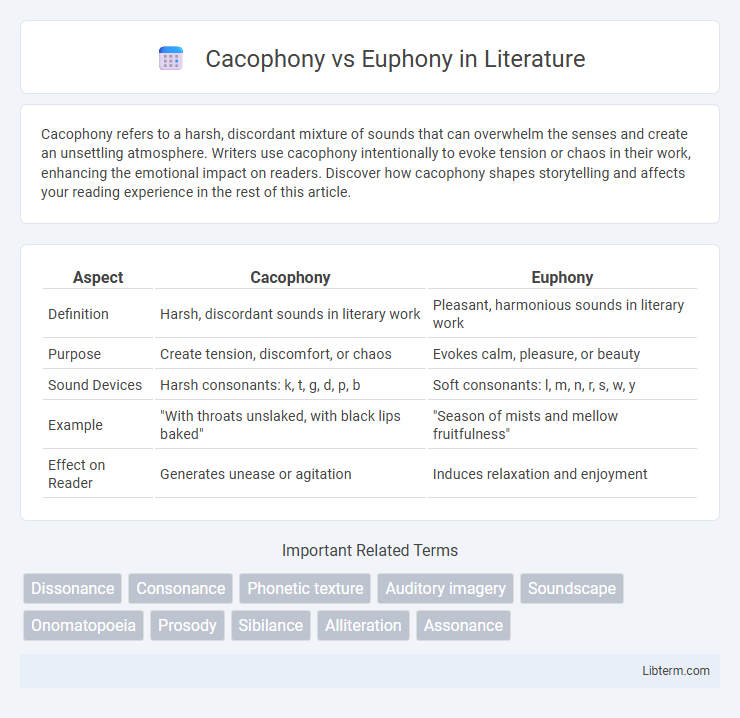Cacophony refers to a harsh, discordant mixture of sounds that can overwhelm the senses and create an unsettling atmosphere. Writers use cacophony intentionally to evoke tension or chaos in their work, enhancing the emotional impact on readers. Discover how cacophony shapes storytelling and affects your reading experience in the rest of this article.
Table of Comparison
| Aspect | Cacophony | Euphony |
|---|---|---|
| Definition | Harsh, discordant sounds in literary work | Pleasant, harmonious sounds in literary work |
| Purpose | Create tension, discomfort, or chaos | Evokes calm, pleasure, or beauty |
| Sound Devices | Harsh consonants: k, t, g, d, p, b | Soft consonants: l, m, n, r, s, w, y |
| Example | "With throats unslaked, with black lips baked" | "Season of mists and mellow fruitfulness" |
| Effect on Reader | Generates unease or agitation | Induces relaxation and enjoyment |
Introduction to Cacophony and Euphony
Cacophony refers to a harsh, discordant mixture of sounds often used in literature and music to evoke tension or discomfort. Euphony, in contrast, denotes a pleasing, harmonious arrangement of sounds that create a sense of calm and beauty. Both concepts play crucial roles in poetry and prose, shaping the auditory experience and emotional impact on the audience.
Defining Cacophony in Literature
Cacophony in literature refers to the use of harsh, discordant sounds that create a jarring or unsettling effect, often achieved through consonant-heavy word choices like "clash," "grind," and "grate." This technique contrasts with euphony, which employs harmonious, melodious sounds to produce a pleasing auditory experience. Writers use cacophony to evoke tension, discomfort, or chaos, enhancing the emotional impact and mood within a narrative or poem.
The Essence of Euphony in Language
Euphony in language emphasizes harmonious and melodious sounds that enhance readability and listener engagement by creating a smooth, pleasing auditory experience. It employs syllabic patterns, soft consonants, and vowel combinations to evoke calmness and beauty in poetry, prose, and speech. The essence of euphony lies in its ability to influence emotional response and aesthetic appreciation through the deliberate choice of phonetically appealing language.
Key Differences: Cacophony vs Euphony
Cacophony involves harsh, discordant sounds that create a jarring auditory effect, often used in poetry and prose to evoke discomfort or tension, while euphony consists of smooth, harmonious sounds that produce a pleasing and melodious auditory experience. The key difference lies in their phonetic qualities: cacophony relies on abrupt, clashing consonants like "k," "t," and "g," whereas euphony emphasizes soft vowels and liquid consonants such as "l," "m," and "n." Writers and speakers strategically use cacophony to convey chaos or conflict, whereas euphony enhances aesthetic appeal and emotional calmness in language.
Literary Devices: Tools for Sound
Cacophony and euphony are literary devices that manipulate sound to evoke specific emotional responses in literature. Cacophony employs harsh, jarring consonant combinations to create a discordant auditory effect, often used to convey chaos or tension. Euphony, in contrast, utilizes smooth, harmonious sounds with soft consonants and vowels to produce a pleasing, melodious effect, enhancing the beauty or tranquility of a passage.
Famous Examples of Cacophony
Famous examples of cacophony include the harsh, discordant sounds in Edgar Allan Poe's "The Bells," where repeated consonants mimic the ringing of iron bells clashing. Shakespeare's "Sound and Fury" speech from Macbeth is another notable instance, using jarring, abrupt sounds to convey chaos and violence. These literary works employ cacophony deliberately to evoke strong emotional responses through unsettling, grating auditory effects.
Memorable Uses of Euphony
Euphony, characterized by harmonious and pleasant sounds, enhances literary works through memorable uses in poetry and prose that evoke soothing and melodic imagery. Classic examples include Edgar Allan Poe's "The Raven," where soft consonants and fluid vowel sounds create an eerie yet captivating musicality. The careful selection of words in Shakespeare's sonnets further demonstrates euphony's power to convey beauty and emotional depth, making the language resonate deeply with readers.
Impact on Reader’s Experience
Cacophony creates a harsh, jarring effect through discordant sounds that evoke discomfort or tension, intensifying the reader's emotional response. Euphony employs harmonious, melodic sounds that produce a soothing and pleasant auditory experience, enhancing feelings of calm and pleasure. These contrasting sound patterns significantly shape the atmosphere and tone, directly influencing how readers engage with and interpret the text.
Practical Tips for Writers
Writers can enhance their prose by balancing cacophony, which involves harsh, discordant sounds, and euphony, characterized by smooth, melodious tones to affect reader emotion and rhythm. Employing euphonic devices such as alliteration, assonance, and consonance generates pleasing auditory effects, while intentional cacophony using harsh consonants like "k," "t," and "g" can create tension or convey chaos. Practical tips include reading aloud to assess sound quality, varying sentence length, and strategically placing cacophonous or euphonious words to align with narrative mood and pacing.
Conclusion: Balancing Sound in Writing
Achieving a balance between cacophony and euphony enhances the reader's auditory experience by blending harsh, jarring sounds with harmonious, smooth tones. Writers strategically employ cacophony to evoke tension or discomfort, while euphony creates a soothing, melodic rhythm that appeals to the senses. Mastery of this balance contributes to more dynamic, expressive, and impactful literary works.
Cacophony Infographic

 libterm.com
libterm.com